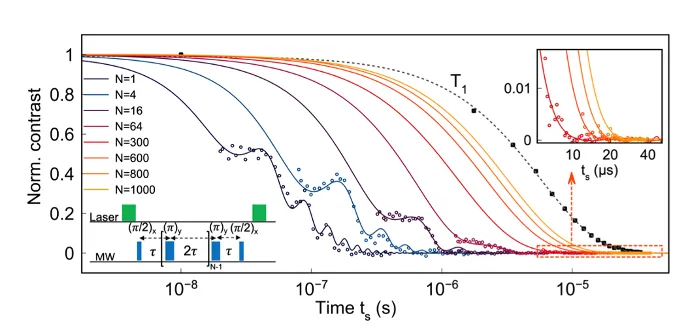Technology Development-Novel solid state spin defects
Quantum sensing with spin defects in hexagonal-boron nitride.
Optically active spins in hexagonal boron nitride (hBN) attract increased attention recently due to room temperature operation and the possible co-integration of the spin defect sensors into ultra-thin semiconductor heterostructures. The VB- spin (S=1) can be addressed by means of optically detected magnetic resonance (ODMR). However, the optical readout contrast of the VB- spin state is relatively low and decays quickly, rendering the use for quantum sensing applications limited until more efficient microwave control and optimized defect creation with long spin phase coherence times are developed. Here, we demonstrate coherent control of the VB- spin defects and utilize a pulsed dynamical decoupling protocol CPMG to extend the T2 coherence time by up to two orders of magnitude (Figure 1). With the increased spin coherence time we address new applications such as the detection of AC magnetic fields and sequences for ambient quantum imaging.

Figure: Extending the coherence time of the optically active spin defect. Using dynamical decoupling sequences with various number of pulses (designated in the left of the Figure), the coherence time can be extendet by about two orders of magnitude. This enables the used of advanced quantum sensing techniques that were previously unaccesible.
Publications
R. Rizzato, M. Schalk, S. Mohr, P.J. Leibold, J.C. Hermann, F. Bruckmainer, P. Ji, G.V. Astakhov, U. Kentsch, M. Helm, A.V. Stier, J.J. Finley, D.B. Bucher°, Extending the coherence time of spin defects in hBN enables advanced qubit control and quantum sensing. Nature Communications, 14, 5089 (2023)